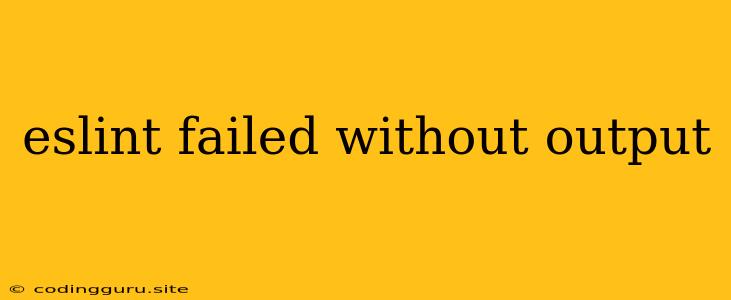Why is ESLint Failing Without Output?
Have you ever encountered a frustrating scenario where ESLint runs but doesn't produce any output, leaving you wondering what's going wrong? This silence can be particularly puzzling, especially when you're expecting error messages or warnings to guide your code quality. This article delves into the reasons behind this cryptic "ESLint failed without output" behavior and provides troubleshooting steps to help you get back on track.
Common Culprits Behind Silent ESLint Failures
1. Incorrect Configuration:
- Missing Configuration File: Ensure you have an ESLint configuration file (
.eslintrc.js,.eslintrc.json, or.eslintrc.yaml) in your project's root directory. This file defines the rules and settings for your linter. Without it, ESLint may not know how to process your code.
2. Parsing Issues:
- Unrecognized File Type: ESLint might struggle to parse files with unusual extensions or syntax if they're not configured properly in your
.eslintrcfile. Make sure the file type and parser are defined correctly within your configuration.
3. Plugin and Extension Errors:
- Incompatible Plugins: If you're using plugins to extend ESLint's functionality, ensure their versions are compatible with your ESLint version. Check the plugin documentation for compatibility information.
4. Command-line Arguments:
- Incorrect Flags: Verify the command-line arguments you're using to run ESLint. Incorrect flags or missing arguments could lead to unexpected behavior. For example, if you're trying to lint a specific file but use the wrong flag, ESLint might not produce any output.
Troubleshooting Steps
1. Check Your Configuration:
- Validate Your
.eslintrc: Use a validator like to verify the syntax and structure of your configuration file. - Examine Plugin Definitions: Ensure your
.eslintrcfile correctly imports and configures all necessary plugins. - Inspect File Extensions: Make sure ESLint is configured to handle the file types you are using (e.g.,
.js,.jsx,.ts).
2. Analyze the Parsing Process:
- Test with a Simple File: Create a basic JavaScript file with minimal code and attempt to lint it. If it works, the issue likely lies in a specific file within your project.
- Debug with
--debug: Run ESLint with the--debugflag (eslint --debug) to get more detailed information about the parsing process and potential errors.
3. Investigate Plugin Errors:
- Check Plugin Versions: Ensure you are using the latest stable versions of all plugins.
- Update ESLint: If you're facing plugin compatibility issues, try updating your ESLint installation.
4. Review Command-line Arguments:
- Refer to Documentation: Consult the ESLint documentation for proper usage of command-line arguments.
- Experiment with Flags: Try different command-line flags to see if they affect the output.
Example Scenario: Incorrect Plugin Configuration
// .eslintrc.js
module.exports = {
// ...other configuration
plugins: ['react'],
};
Problem: The react plugin isn't properly configured in this example. ESLint might be failing to load it, resulting in no output.
Solution: Install and configure the react plugin correctly:
npm install eslint-plugin-react
// .eslintrc.js
module.exports = {
// ...other configuration
plugins: ['react'],
parserOptions: {
ecmaFeatures: {
jsx: true,
},
},
rules: {
// ... rules
},
};
Conclusion
ESLint failing without output can be a frustrating experience, but it's usually a sign of a configuration or plugin issue. By carefully examining your configuration, parsing process, plugins, and command-line arguments, you can isolate and resolve the underlying problem. Remember that debugging and understanding your project's setup are key to getting your linter back on track.
